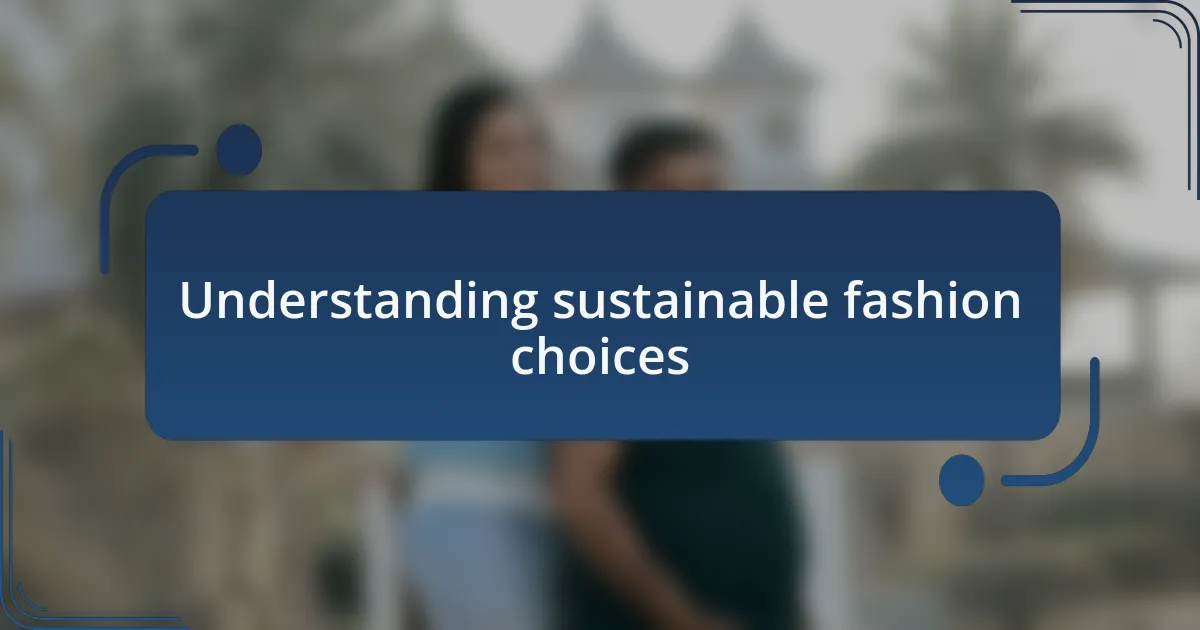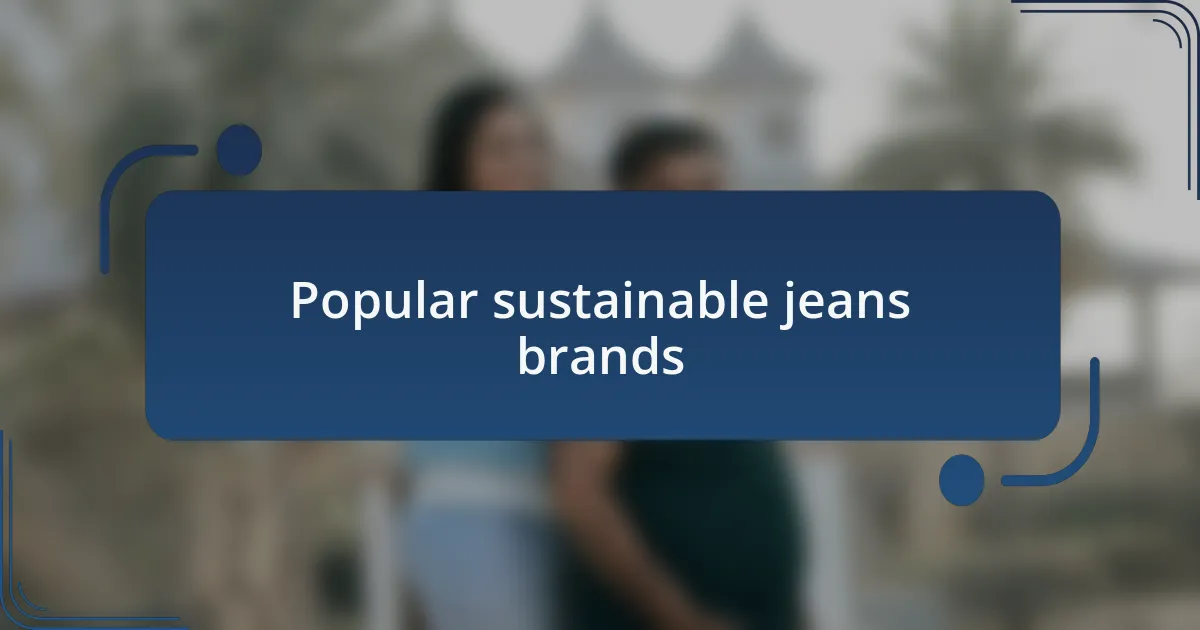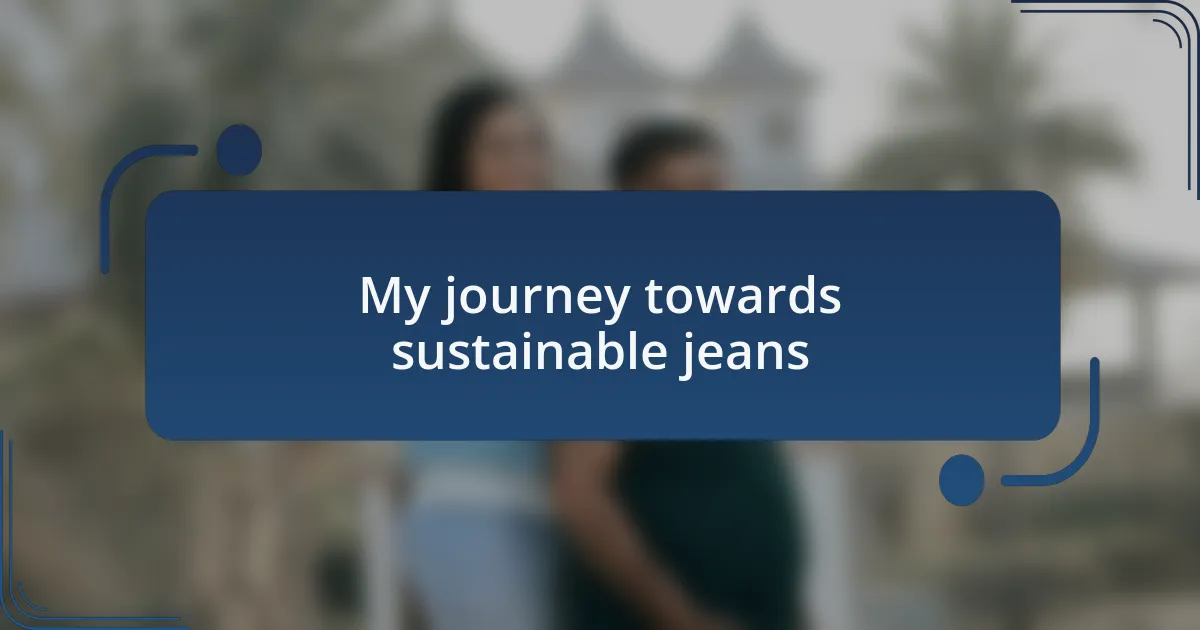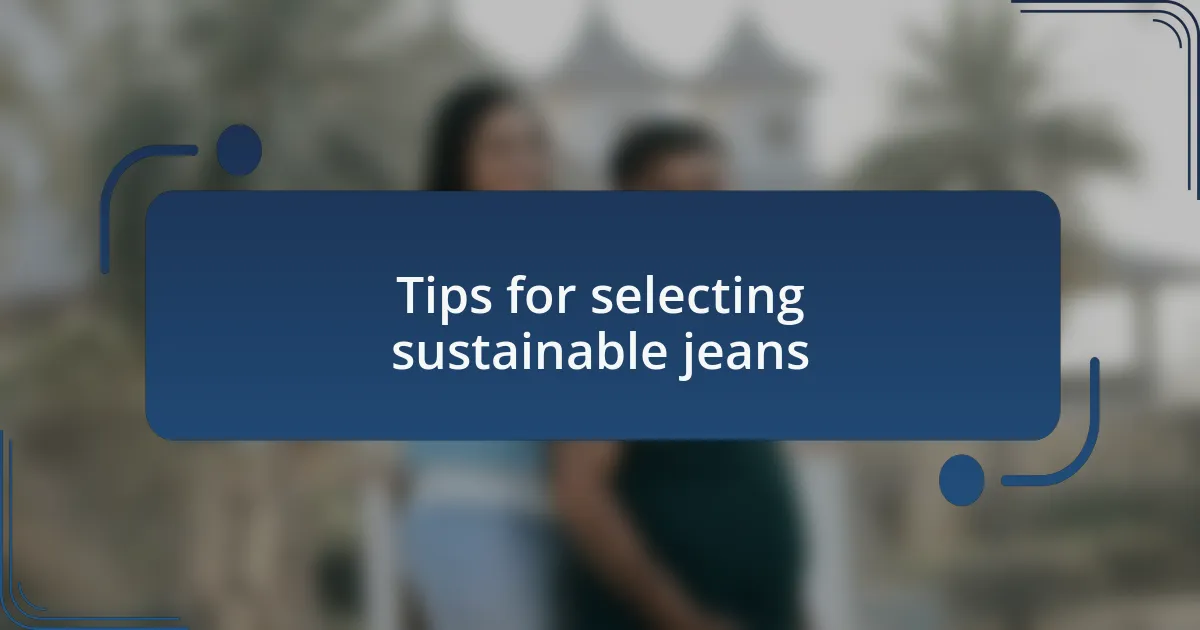Key takeaways:
- Sustainable fashion involves conscious consumption, considering the entire lifecycle of garments and their impact on the environment.
- Supporting sustainable jeans brands promotes ethical labor practices and encourages industry-wide change towards transparency and sustainability.
- Key features of sustainable jeans include the use of organic or recycled materials, ethical manufacturing processes, and durability, which reduces waste.
- Choosing sustainable options and considering second-hand clothing can deepen appreciation for fashion while contributing to environmental responsibility.

Understanding sustainable fashion choices
Sustainable fashion is more than just a trend; it embodies a mindset shift towards conscious consumption. When I first discovered the impact of fast fashion on our planet, it left me feeling both shocked and motivated. Have you ever thought about where your clothes end up after you no longer wear them? Understanding this interconnectedness is essential to making informed choices.
For me, sustainable fashion means considering the entire lifecycle of a garment—from its production to its ultimate disposal. I’ll never forget the moment I chose to invest in a pair of ethically produced jeans instead of the typical mass-market option. It wasn’t just about looking good; it felt like I was participating in a larger movement towards environmental responsibility.
One of the most enlightening aspects of sustainable fashion is the realization that every choice matters. I often ask myself, what story do my clothes tell? Each piece I own now represents a commitment to ethical practices, which inspires me to share these values with friends and family. As we navigate our fashion choices, let’s remember that it’s not just about style; it’s about making choices that align with our values and positively impact the world.

Importance of sustainable jeans brands
Sustainable jeans brands play a crucial role in reducing the environmental impact of the fashion industry. When I made the switch to purchasing denim from brands that prioritize eco-friendly practices, I genuinely felt like I was contributing to a solution. It’s amazing how a single garment can encapsulate such powerful changes in production techniques and resource management.
One day, while sorting through my closet, I stumbled upon a pair of jeans that had been made with organic cotton and natural dyes. I paused and thought about the difference between that pair and the typical denim filled with chemicals and synthetic materials. Suddenly, it wasn’t just about the jeans; it became a reflection of my values—my commitment to a healthier planet and ethical labor practices. Isn’t that a compelling reason to choose sustainable options?
The power of sustainable jeans brands extends beyond personal choices; they inspire industry-wide change. With more consumers demanding transparency and accountability, these brands lead the way in challenging the status quo. I often wonder, what if we all embraced this mindset? When we support sustainable brands, we encourage a culture of innovation that can potentially reshape the entire fashion landscape.

Key features of sustainable jeans
Sustainable jeans are often crafted from organic and recycled materials, significantly reducing the need for harmful pesticides and water usage associated with conventional cotton farming. I remember the first time I slipped into a pair made from recycled denim—I was struck not just by how comfortable they felt, but also by the realization that I was wearing something that embodied sustainability. Doesn’t it feel good to know that your clothing choices are actively playing a part in minimizing environmental harm?
Another key feature to consider is the production process. Many sustainable jeans brands focus on ethical manufacturing, ensuring fair labor practices and safe working conditions. I once visited a local brand that proudly showcased their factory, where workers were treated with respect and paid fair wages. It left me wondering, how often do we think about the people behind our clothes? Connecting with those stories makes the act of wearing jeans much more meaningful.
Finally, the durability of sustainable jeans stands out as an essential characteristic. These jeans are often designed to last longer, reducing the frequency of replacement and, in turn, minimizing waste. I still have several pairs that have withstood countless washes and wear, and I can’t help but feel a sense of pride every time I put them on. It’s like wearing a badge of honor for my commitment to sustainability, reinforcing the idea that fashion can be both stylish and responsible.

Popular sustainable jeans brands
When it comes to popular sustainable jeans brands, one that stands out to me is Levi’s. Their Water Another brand that caught my attention is Reformation. Known for their trendy styles and commitment to low-impact materials, I find myself drawn to their collection again and again. I recently wore a pair of their jeans to an event, feeling both fashionable and eco-conscious. It made me wonder how many people notice the brands behind their clothing choices, and if they realize how impactful their purchases can be. Lastly, there’s Everlane, which focuses on transparency and ethical practices. I often reflect on this when I wear their jeans, knowing exactly where they come from and how they were made. The simplicity of their designs complements my wardrobe, and each time I wear them, I’m reminded of the power of informed consumerism. Isn’t it fascinating how our jeans can be a conversation starter about sustainability?

My journey towards sustainable jeans
As I ventured deeper into sustainable fashion, my perspective on denim began to shift. I remember a pivotal moment when I stumbled upon a second-hand shop, discovering a pair of vintage jeans that not only fit me like a glove but also had a story of their own. The thrill of giving new life to pre-loved clothing sparked a realization: these jeans were more than just fabric; they were part of a cycle that respected our planet.
Transitioning to sustainable jeans has been a transformative experience. I recall wearing a pair made from organic cotton at a casual gathering, feeling a sense of pride swelling within me. I could sense the curiosity of my friends as they asked about my outfit, and each mention of its sustainable origin felt like a small victory in raising awareness. Could something as simple as jeans really inspire conversations about environmental responsibility?
The journey hasn’t always been easy, though. I’ve faced questions about price and availability, especially when I first decided to explore ethical brands. Still, every time I invest in a pair of jeans that aligns with my values, the satisfaction I feel outweighs the cost. It begs the question: isn’t our planet worth a little extra effort in making ethical choices?

Tips for selecting sustainable jeans
When selecting sustainable jeans, I’ve found it crucial to look at the fabric composition. Opt for jeans made from organic cotton, Tencel, or recycled materials, as these choices significantly reduce environmental impact. The moment I switched to organic cotton, it was like wearing a cloud—so comfortable and better for the Earth.
Another essential tip is to research the brand’s practices. I remember discovering a brand that not only used eco-friendly materials but also ensured fair labor conditions. It made me feel more connected to my purchase; knowing the people behind those jeans were treated ethically made wearing them even more special. Isn’t it amazing how much more meaningful our fashion choices can be when we consider their entire journey?
Lastly, don’t shy away from second-hand options. Each time I explore thrift stores, I stumble upon unique pieces that carry their own histories, much like the vintage jeans that helped me kickstart this journey. It’s a reminder that sustainability often lies in reuse—doesn’t it create a deeper appreciation for fashion when we see it as part of a larger story?